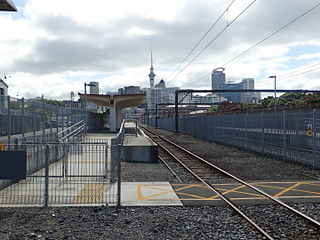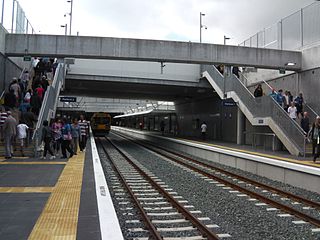
Henderson railway station is a major station on the Western Line of the Auckland railway network in New Zealand. It is located near the town centre of Henderson, the western administration offices of Auckland Council, and a major shopping centre, WestCity Waitakere.

Mount Eden railway station was a Western Line station of the Auckland railway network in the Auckland suburb of Mount Eden in New Zealand. It had an island platform, and was reached via a footbridge from Mount Eden Rd or from the level crossing between Ngahura Street and Fenton Street. The station closed in 2020 to enable the construction of a new station and connections for the City Rail Link. The name of the replacement is Maungawhau / Mount Eden railway station; it is due to open in 2024.

Newmarket railway station is a station in the inner-city suburb of Newmarket in Auckland, New Zealand. It serves the Southern, Onehunga and Western Lines of the Auckland railway network, and is the second-busiest station in Auckland, after Britomart.

Greenlane railway station serves the Southern Line and Onehunga Line of the Auckland railway network. It was opened circa 1877. It has an island platform and is reached via a ramp from Green Lane East. It is the nearest station to Ellerslie Racecourse, Greenlane Clinical Centre, ASB Showgrounds and Cornwall Park.

Ellerslie railway station serves the Southern and Onehunga Lines of the Auckland railway network in New Zealand. It was opened in 1873. It has an island platform and is 1.37 km (0.85 mi) south of Greenlane and 1.45 km (0.90 mi) north of Penrose.

Penrose railway station is a station at Penrose, Auckland, on the Southern Line of the Auckland railway network, New Zealand. It has an island platform and is reached by pedestrian over bridges from Great South Road and Station Road. It still has its original wooden station building on the platform.

The Newmarket Line is a railway line in Auckland, New Zealand, that runs between Quay Park Junction, near Britomart Transport Centre, and Newmarket Train Station. It is 2.64 km long. It connects the North Island Main Trunk (NIMT), which runs from the east into Britomart via the waterfront, and the North Auckland Line (NAL), which runs between Westfield Junction and Otiria via Newmarket and Whangarei. It has been named the Newmarket Line since 2011. From 1996 to 2011, it was named the Auckland–Newmarket Line, as it ran from Auckland Railway Station until the station closed in 2003. From 1977 to 1996, it was named the Newmarket Branch Railway.

The Strand Station, also referred to as Auckland Strand Station, is a railway station located on the eastern edge of the Auckland CBD. It serves as the long-distance railway station for Auckland. It is the northern terminus of the Northern Explorer service between Auckland and Wellington, and the northern terminus for the Te Huia service on Saturdays from 24 July 2021. Suburban services are not scheduled to pass through the station, however, it serves as a backup for Britomart Transport Centre during times of disruption.

The Onehunga Branch railway line is a section of the Onehunga Line in Auckland, New Zealand. It was constructed by the Auckland Provincial Government and opened from Penrose to Onehunga on 24 December 1873, and extended to Onehunga Wharf on 28 November 1878. It is 3.6 kilometres (2.2 mi) in length and is single-track only.
Transport in Auckland, New Zealand's largest city, is defined by factors that include the shape of the Auckland isthmus, the suburban character of much of the urban area, a history of focusing investment on roading projects rather than public transport, and high car-ownership rates.

Public transport in Auckland, the largest metropolitan area of New Zealand, consists of three modes: bus, train and ferry. Services are coordinated by Auckland Transport under the AT Metro brand. Britomart Transport Centre is the main transport hub.
The Western Line in Auckland, New Zealand is the name given to suburban rail services that operate between Britomart and Swanson via Newmarket.

Auckland railway electrification occurred in phases as part of investment in a new infrastructure for Auckland's urban railway network. Electrification of the network had been proposed for several decades. Installation started in the late 2000s after funds were approved from a combination of regional and central government budgets.

Grafton Railway Station is a station serving the inner-city suburb of Grafton in Auckland, New Zealand. It is located on the Western Line of Auckland's passenger rail network and consists of an island platform located in a trench near the intersection of Khyber Pass Road and Park Road. The station opened on 11 April 2010.

The City Rail Link (CRL) is a rail project currently under construction in Auckland, New Zealand. The project consists of a 3.5 km long double-track rail tunnel underneath Auckland's city centre, between Britomart Transport Centre and Mount Eden railway station. Two new underground stations will be constructed to serve the city centre: Te Waihorotiu near Aotea Square and Karanga-a-Hape near Karangahape Road. Britomart will be converted from a terminus station into a through station and Mount Eden station will be completely rebuilt with four platforms to serve as an interchange between the new CRL line and the existing Western Line.

The Auckland Airport Line was a proposed heavy rail line in Auckland, New Zealand, that would have linked Auckland Airport with the Auckland central business district via central isthmus suburbs.

Manukau railway station is located at the heart of the campus of the Manukau Institute of Technology in Manukau, a suburb of Auckland, New Zealand. It is the terminus station for Eastern Line services between Manukau and Britomart Transport Centre in central Auckland.
Auckland, New Zealand's largest city, is considering introducing light rail lines to replace some of its most heavily used bus routes. Many of these new light rail lines, if built, would reuse the routes of Auckland's former tram system. Light rail systems have been proposed in Auckland throughout the late-20th and 21st centuries following the closure of the tram system in the 1950s.
The Onehunga Line in Auckland, New Zealand is the name given to suburban train services that operate between Newmarket and Onehunga.
























